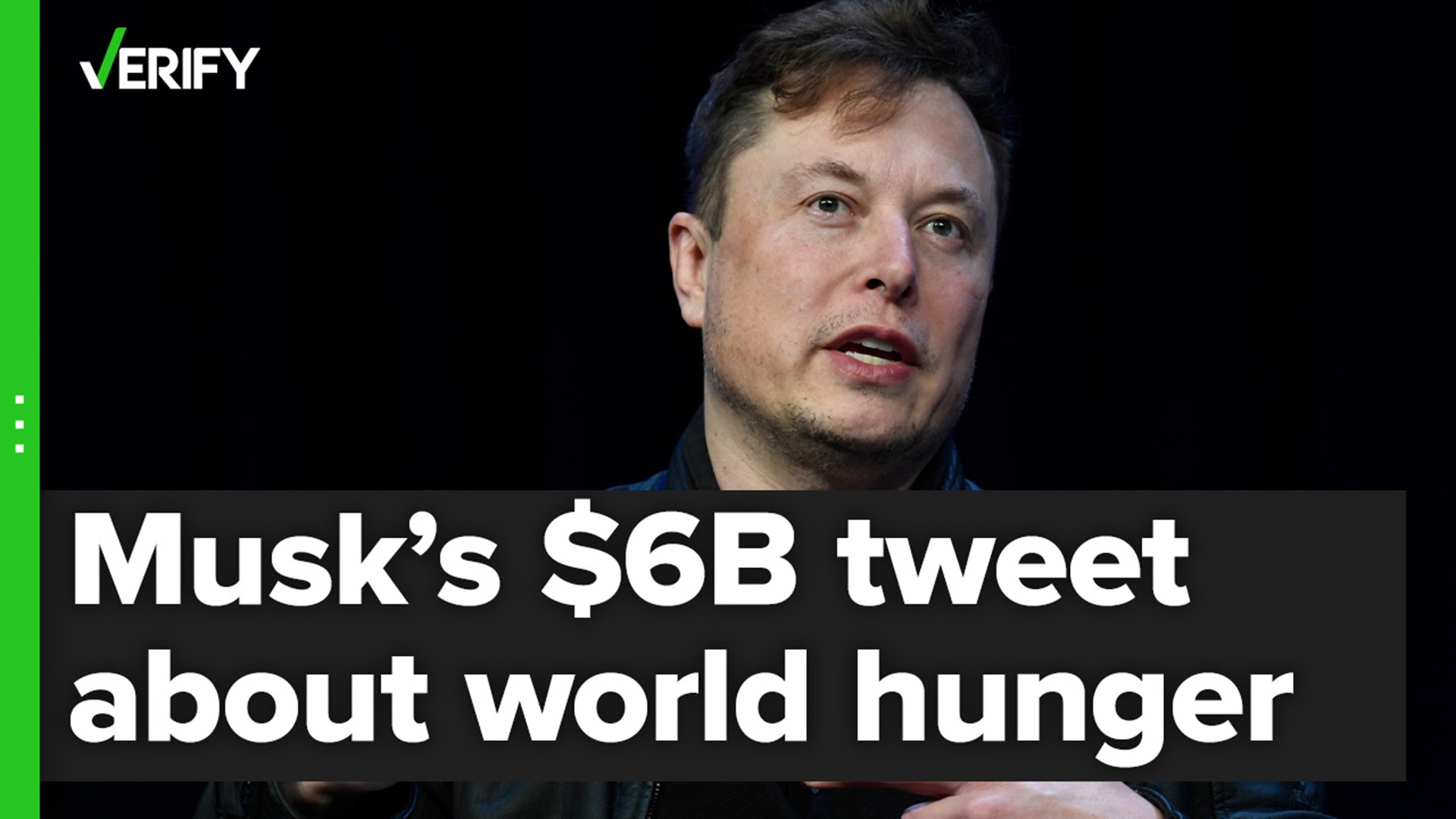Once news of Elon Musk’s agreement to buy Twitter for $44 billion became public, several tweets alleging that Musk had previously promised to give the United Nations’ World Food Programme $6 billion to end world hunger, but never delivered, went viral.
One of those tweets, authored by podcast host Brian Tyler Cohen, was liked more than 500,000 times. Another tweet referencing the claim, made by actor and comedian River Butcher, was liked more than 250,000 times.
THE QUESTION
Did Elon Musk tweet that he would donate $6 billion to the UN World Food Programme to fight world hunger?
THE SOURCES
THE ANSWER
Yes, Elon Musk tweeted that he would donate $6 billion to the UN World Food Programme to fight world hunger. His conditions were that they give him a detailed plan on how the money would be spent. That plan came two weeks later.
WHAT WE FOUND
On Oct. 31, 2021, Elon Musk replied to a screenshot of a CNN headline that read “2% of Elon Musk's wealth could solve world hunger, says director of UN food scarcity organization” by stating that if the United Nations’ (UN) World Food Programme (WFP) could “describe on this Twitter thread exactly how $6B will solve world hunger, I will sell Tesla stock right now and do it.”
The UN WFP chief, David Beasley, replied to Musk directly to tell him the headline was not accurate, and that $6 billion wouldn’t solve world hunger, but it would save 42 million people “on the brink of starvation.” CNN corrected its headline the next day to say Musk’s wealth “could help solve” world hunger instead of solving it entirely.
Musk and Beasley replied to each other several times, and Musk eventually asked Beasley to publish the WFP’s current and proposed spending in detail so the public could see exactly where the money would go.
Beasley told Musk that WFP’s financial statements, operational documents, independent evaluation reports, audits and annual global and country performance reports for the last 10 years are all public and on WFP’s website, which he linked. He then linked a “simple snapshot” of WFP’s plan to use $6.6 billion to save 42 million people on the brink of famine and said an “extensive detailed plan” would follow in the coming days.
Musk did not reply to Beasley’s tweet about WFP’s financial statements, nor did he reply to the WFP chief’s tweet with the snapshot.
WFP published its plan on Nov. 15 and updated the snapshot page with said plan. Beasley tweeted it out in a separate thread from the original and tagged Musk in a tweet with a link to the plan. The plan broke down how much money would be spent in each region, as well as how much would go to each of the 10 countries receiving the most money. It also categorized how the money would be used — dividing its planned spending into food, vouchers for cash and food, program creation and logistics. WFP planned to spend $3.5 billion on food and its delivery, and $2 billion on cash and food vouchers.
While the WFP plan did summarize what is included in the planned spending for each category — for example, food and food delivery included the cost of shipping and transport to the country, plus warehousing and final delivery to the specific people and communities in need of food, contracted truck drivers and required security escorts in conflict-affected zones to distribute food — it did not detail how much money it planned to allocate to each of these facets within the broad categories.
Musk never replied to Beasley’s thread, and he has not since tweeted anything about WFP’s published plan.
A February Securities and Exchange Commission (SEC) filing revealed that Musk had donated Tesla stocks that were then-worth $5.7 billion to an unspecified charity in mid-to-late November, with the first donation coming a few days after Beasley and WFP published their plan.
Musk hasn’t revealed where he donated that money, and neither WFP nor any other charitable organization has since claimed to have received that donation. In February, WFP told Fortune that it had not received a donation from Musk as of yet.

